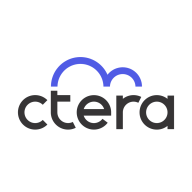


CTERA Enterprise File Services Platform and Azure NetApp Files are competing in the cloud file services space. CTERA has advantages in pricing, but Azure NetApp Files is preferred for its robust feature set.
Features: CTERA Enterprise File Services Platform offers hybrid cloud capabilities, secure file sharing, and efficient data management. Azure NetApp Files provides robust scalability, high availability, and seamless cloud-native integration.
Room for Improvement: CTERA could enhance its feature set to match Azure's extensive capabilities. Improvements in cloud-native integrations could benefit Azure NetApp Files. Both products can work on decreasing initial setup complexity and enhancing security measures.
Ease of Deployment and Customer Service: CTERA boasts a streamlined deployment process with strong hybrid integration and reliable customer service. Azure NetApp Files requires more initial setup but offers superior support and cloud-native benefits, making it preferable for long-term management.
Pricing and ROI: CTERA typically offers lower setup costs and encourages efficient ROI, appealing to budget-conscious clients. Azure NetApp Files comes with a higher initial investment but justifies it with advanced features that improve operational efficiency and long-term value.
Adding SSD storage to Windows file servers is expensive, and we no longer need to back up those devices.
I am positive that CTERA has helped reduce the total cost of ownership by eliminating the need for manual storage management and reducing storage service processes.
They have top-notch people.
They swiftly address concerns and take ownership of the call, providing a very satisfactory support experience.
High-priority issues are handled promptly.
I would rate their support a ten out of ten.
If we need to upgrade CPU and memory, we should be able to do that without a license upgrade.
CTERA is a very scalable product, allowing us to grow.
It offers good scalability options, including vertical and outward scalability.
It has been pretty stable since then.
We had things deployed for years, and we were suddenly getting cloud sync issues that were crashing our sites.
It is very stable and reliable.
I would like for them to have more compression so that it can avoid using more storage.
AI and automation features could enhance the platform, such as AI-powered search, predictive storage analytics, and intelligent alerts for proactive monitoring.
It would help to have a global single-pane-of-glass view of all my CTERA devices.
One suggested improvement for the CTERA Enterprise File Services Platform is the ability to distribute data across multiple active backend storage nodes rather than the current limitation of a single active node.
It is expensive, especially with NetApp Ultra Storage.
Unlike other solutions that require hardware purchases, CTERA offers software licensing with flexibility across multiple infrastructure providers.
CTERA's pricing seems to be on par with some of the other players, such as Nasuni and Azure.
I find the pricing reasonable.
The most valuable feature is that the sixty-terabyte database snapshot can be done in less than two to three minutes.
As soon as something is written to the device, CTERA copies it to the cloud, where it's versioned with snapshots so we can recover it.
A vital advantage of this platform is its instantaneous recovery capability, allowing seamless access to a secondary gateway if the primary one fails.
It is a three-in-one solution for us. It is a file-sharing platform, an archiving solution, and also a backup solution.



IBM Turbonomic offers automation, planning, and right-sizing recommendations to streamline resource management, improve efficiencies, and optimize costs across virtualized environments and cloud platforms.
IBM Turbonomic is valued for its capability to optimize resource allocation and monitor virtual environments efficiently. It facilitates automated decision-making in VM sizing, load balancing, and cost optimization for both on-premises and cloud deployments. Users can leverage insights for workload placement, ensure peak performance assurance, and effectively right-size across VMware and Azure. The ongoing transition to HTML5 aims to improve visual and navigational ease, while expanded reporting features are anticipated. Opportunities for improved training, documentation, and integrations enhance platform usability and functionality.
What Are the Key Features?In finance, IBM Turbonomic aids in maintaining platform efficiency during market fluctuations. Healthcare organizations leverage its capability for resource optimization during high-demand periods to enhance patient care support. Retailers use it for planning in peak seasons, ensuring resources align with fluctuating demand to maintain performance continuity.
Azure NetApp Files is designed for unstructured data, virtualized SAP systems, SQL backups, NFS and CIFS protocols, Azure Virtual Desktop storage, and optimizing file share services. It supports high performance and networking integration in Microsoft Azure.
Azure NetApp Files offers features such as SnapMirror for data protection, rapid provisioning, elastic scaling, and ultra-fast SQL backup and restore. It provides a seamless experience with fast snapshotting, high availability, security, and ease of setup. Users benefit from significant performance improvements and the ability to manage substantial workload migrations effortlessly. This service is ideal for environments like Azure Kubernetes Service and cloud EPM platforms, where speed, flexibility, and performance are crucial.
What are the key features?Azure NetApp Files is implemented in various industries requiring robust file storage solutions, from educational environments where performance boosts are critical to businesses leveraging Azure Kubernetes Service for containerized applications. It supports high-demand environments, optimizing data management and improving efficiency.
The CTERA Enterprise File Services Platform provides a cloud-native global file system over public and private object storage, revolutionizing the world of hybrid cloud data solutions. Enhanced by a rich data services ecosystem, CTERA enables enterprises to gain full control of their data for optimal edge performance, data insight, and governance. The platform focuses on security, providing features like data encryption, access controls, and ransomware protection. Centralized management tools enable efficient data control and monitoring. The platform is being used to replace legacy NAS and file servers, especially at remote locations, and simplify backup and disaster recovery of file data while providing the flexibility of multi-cloud deployments with infinite scalability. CTERA is at the core of hybrid cloud transformations of some of the world’s largest banks, healthcare organizations, global media groups, and government agencies, in deployments that scale to tens of petabytes.
We monitor all Cloud Migration reviews to prevent fraudulent reviews and keep review quality high. We do not post reviews by company employees or direct competitors. We validate each review for authenticity via cross-reference with LinkedIn, and personal follow-up with the reviewer when necessary.